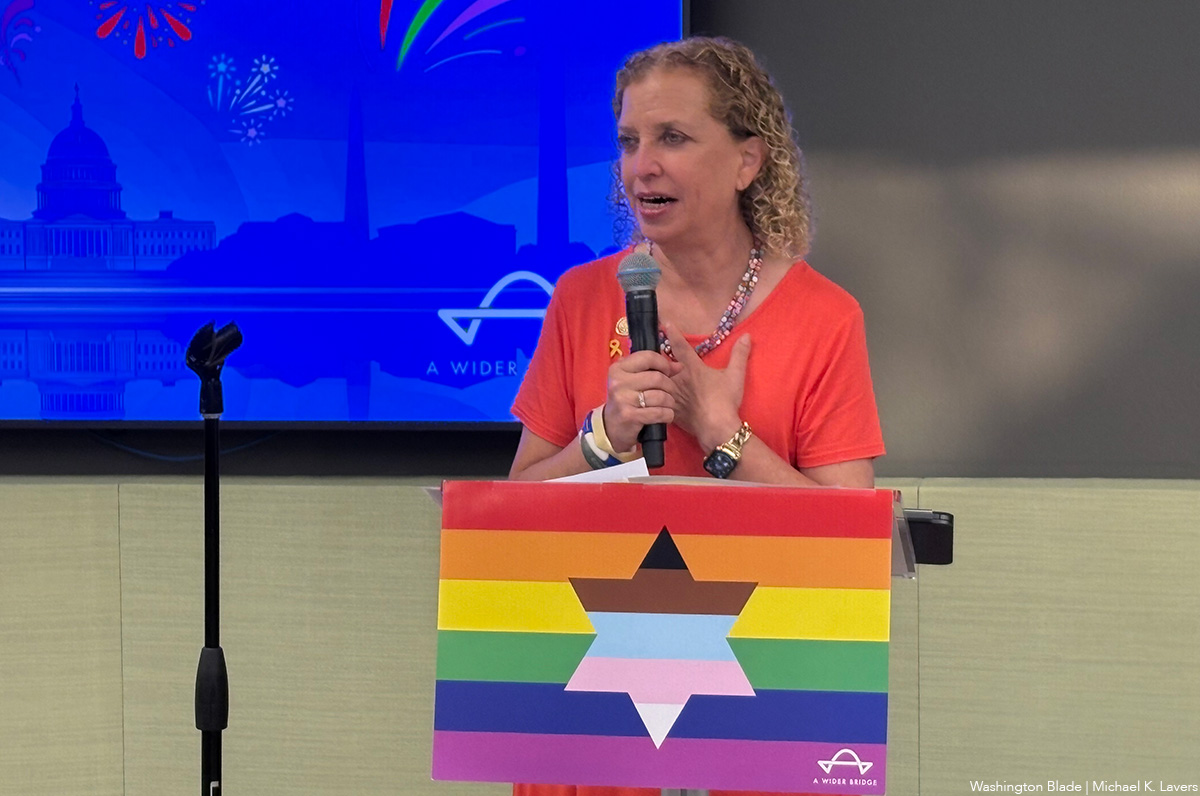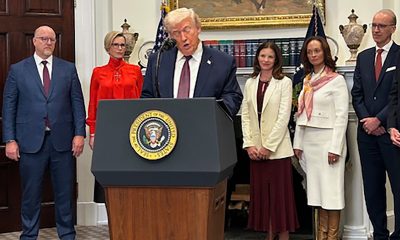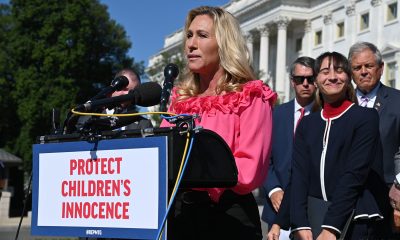National
What will the Tenth Circuit do with Utah marriages?
Don’t read too much into court decision to reject a stay: experts
As celebrations continue in Utah following its surprise entry as a marriage equality state, one lingering question is whether the U.S. Tenth Circuit Court of Appeals will allow gay couples to continue to marry there.
The court will face two questions regarding the ruling by U.S. District Judge Robert Shelby that the state’s ban on same-sex marriage is unconstitutional. First, whether to institute a stay on Utah’s same-sex marriages as it considers the decision on appeal, and second, whether to overturn or uphold the district court decision.
Suzanne Goldberg, a lesbian and co-director of Columbia University’s Center for Gender & Sexuality Law, said Sunday the Tenth Circuit’s previous rejections of a stay are no indication it’ll decide the same way the next time around.
“I know the 10th circuit declined to issue a stay today, but that decision is consistent with standard procedure, which provides that the district court should rule on a stay request before the appellate court responds,” Goldberg said. “The decision does not tell us what the court will do if and when the stay request is properly presented.”
Appeals courts have made various decisions on whether to institute a stay on same-sex marriages as marriage equality litigation has advanced. The U.S. Ninth Circuit Court of Appeals issued a stay on same-sex marriages after it determined California’s Proposition 8 was unconstitutional. But the New Jersey State Supreme Court refused to stay a lower court’s ruling in favor of marriage equality, prompting New Jersey Gov. Chris Christie to drop his defense of the marriage ban.
State officials — Utah Gov. Gary Herbert and the Utah attorney general’s office — have repeatedly sought stays on the weddings, but have been rebuffed by both the district court and the Tenth Circuit. However, the appeals court allowed officials to refile yet again. The Tenth Circuit could make a decision on a stay at any time and is expected to do so soon, perhaps on Christmas Eve.
Brian Brown, president of the National Organization for Marriage, is calling on the Tenth Circuit to issue a stay on the same-sex marriages.
“This decision provokes a constitutional crisis,” Brown said. “Not only is it unlawful, it roils the body politic and does great damage to the people’s confidence in the judicial system itself as a lone federal judge attempts to usurp the sovereignty of the state. We call on the Tenth Circuit to grant an immediate stay so that our higher courts can carefully and thoughtfully consider the profoundly important issues raised by this case.”
In the event that the Tenth Circuit rejects a stay, state officials could take their request to the U.S. Supreme Court.
Rick Hasen, a professor of law and politics at University of California, Irvine, said via Twitter that the request would go to U.S. Associate Justice Sonia Sotomayor, who could refer the issue to the entire court.
Justice Sotyomayor would be first at #SCOTUS to get stay request in Utah gay marriage case http://t.co/FzTPUVRosu
— Rick Hasen (@rickhasen) December 23, 2013
Jon Davidson, legal director for Lambda Legal, said determining which way the Supreme Court will rule on a stay is difficult — even with the precedent of declaring Section 3 of the Defense of Marriage Act unconstitutional.
“Given that couples are now marrying in many other states without any harm to anyone, the Court might choose simply not to get involved at this point, but, as I’ve said, I can’t make any prediction at this point with any degree of confidence,” Davidson said.
Regardless of whether or not the court issues a stay, state officials — Gov. Gary Herbert and newly appointed Utah Attorney General Sean Reyes — have the right to automatic appeal, so the Tenth Circuit has no option but to take up the case on its merits.
The makeup of the U.S. Tenth Circuit Court of Appeals is split just about down the middle between judges appointed by Democrats and Republicans. Three were appointed by President Obama, one by President Clinton, one by President George H.W. Bush, and four by President George W. Bush, making for a 4/5 split of Democratic vs. Republican appointees. There are also two vacancies on the court.
Davidson nonetheless said the political affiliation of the president who appointed a judge doesn’t necessarily predict the way they will decide a case.
“Of course, who appointed a judge does not necessarily tell you how a judge would rule, as some appointees of Democratic presidents have been quite moderate or even, in some states, somewhat conservative, and a number of Republican judges throughout the country have ruled in favor of marriage equality,” Davidson said.
It’s also hard to predict which combination of judges will decide the Utah case. Just as two judges on the court have denied previous stay requests in the case, certain motions, including motions to stay, are randomly assigned to a rotating two-judge panel. In the event of a tie, those judges may request that a third judge be added to decide the matter.
The consistency of the Tenth Circuit stands in contrast to the U.S. Ninth Circuit of Appeals, which has a 27-15 split of Democratic vs. Republican appointees and has a reputation for being a liberal court. The court affirmed California’s Proposition 8 was unconstitutional on the basis that marriage rights for gay couples can’t be rescinded once initially offered, and upheld California’s law prohibiting widely discredited “ex-gay” conversion therapy for minors.
As far as previous rulings, as state officials have noted in their requests for a stay on Utah same-sex marriages, no judge in the Tenth Circuit — at the district or the appeals level — has ever issued an opinion on marriage equality besides Shelby. As the judge noted in his ruling, the Tenth Circuit had determined in 2008 that sexual orientation discrimination doesn’t merit heightened scrutiny, but Shelby said that doesn’t matter because Utah’s ban on same-sex marriage doesn’t pass rational basis review.
But there is precedent for pro-gay rulings in the Tenth Circuit. In 2007, the appeals court in the case of Finstuen v. Crutcher struck down under the Full Faith & Credit Clause an Oklahoma statute barring recognition of adoptions by same-sex couples finalized in another state.
The timing for when the Tenth Circuit will make a decision regarding the appeal also remains in question. As Columbia University’s Goldberg noted, the process can take about a year, but there’s no standard timeline.
“Usually it can take up to a year, or even more, for an appeal to be briefed, argued and decided,” Goldberg said. “In marriage cases, there is a compelling reason for courts to act more quickly because people are being actively denied their rights, but there are no strict rules on the timetable.”
Davidson said it will take at least three months before a briefing is completed in the Kitchen case, but it could be considerably longer if parties seek an extension. More time is needed for oral arguments and for judges to write their decisions.
“Sometimes the period between notice of appeal and decision can be as short as six months or so, and sometimes it can be a matter of years,” Davidson said.
Shelby’s ruling had the distinction of being the first ruling on a marriage ban as a result of a federal lawsuit following the Supreme Court decision against DOMA. While other courts in New Jersey and New Mexico instituted marriage equality following the high court decision, these lawsuits were in state court, not federal court.
However, it’s not the most advanced marriage equality lawsuit. The case against Nevada’s ban on same-sex marriage, Sevcik v. Sandoval, is pending before the U.S. Ninth Circuit Court of Appeals. It remains to be seen which of these two cases, or yet another, will be the first marriage equality lawsuit to reach the Supreme Court in the aftermath of the decisions this year.
However the Tenth Circuit decides, the decision from Shelby is expected to have an impact on other courts evaluating the issue of marriage equality.
Davidson said Lambda Legal submitted a copy of the ruling to the U.S. District Court for the Western District Court just before it allowed a lawsuit challenging a state ban on same-sex marriage in Virginia to proceed.
“Judge Shelby’s opinion is very persuasive, in my view, and I think it will be given significant consideration by other judges deciding these issues,” Davidson said.

A Wider Bridge on Friday announced it will shut down at the end of the month.
The group that “mobilizes the LGBTQ community to fight antisemitism and support Israel and its LGBTQ community” in a letter to supporters said financial challenges prompted the decision.
“After 15 years of building bridges between LGBTQ communities in North America and Israel, A Wider Bridge has made the difficult decision to wind down operations as of Dec. 31, 2025,” it reads.
“This decision comes after challenging financial realities despite our best efforts to secure sustainable funding. We deeply appreciate our supporters and partners who made this work possible.”
Arthur Slepian founded A Wider Bridge in 2010.
The organization in 2016 organized a reception at the National LGBTQ Task Force’s Creating Change Conference in Chicago that was to have featured to Israeli activists. More than 200 people who protested against A Wider Bridge forced the event’s cancellation.
A Wider Bridge in 2024 urged the Capital Pride Alliance and other Pride organizers to ensure Jewish people can safely participate in their events in response to an increase in antisemitic attacks after Hamas militants attacked Israel on Oct. 7, 2023.
The Jewish Telegraphic Agency reported authorities in Vermont late last year charged Ethan Felson, who was A Wider Bridge’s then-executive director, with lewd and lascivious conduct after alleged sexual misconduct against a museum employee. Rabbi Denise Eger succeeded Felson as A Wider Bridge’s interim executive director.
A Wider Bridge in June honored U.S. Rep. Debbie Wasserman Schultz (D-Fla.) at its Pride event that took place at the Capital Jewish Museum in D.C. The event took place 15 days after a gunman killed two Israeli Embassy employees — Yaron Lischinsky and Sarah Milgrim — as they were leaving an event at the museum.
“Though we are winding down, this is not a time to back down. We recognize the deep importance of our mission and work amid attacks on Jewish people and LGBTQ people – and LGBTQ Jews at the intersection,” said A Wider Bridge in its letter. “Our board members remain committed to showing up in their individual capacities to represent queer Jews across diverse spaces — and we know our partners and supporters will continue to do the same.”
Editor’s note: Washington Blade International News Editor Michael K. Lavers traveled to Israel and Palestine with A Wider Bridge in 2016.
The White House
‘Trump Rx’ plan includes sharp cuts to HIV drug prices
President made announcement on Friday

President Donald Trump met with leaders from some of the world’s largest pharmaceutical companies at the White House on Friday to announce his new “Trump Rx” plan and outline efforts to reduce medication costs for Americans.
During the roughly 47-minute meeting in the Roosevelt Room, Trump detailed his administration’s efforts to cut prescription drug prices and make medications more affordable for U.S. patients.
“Starting next year, American drug prices will come down fast, furious, and will soon be among the lowest in the developed world,” Trump said during the meeting. “For decades, Americans have been forced to pay the highest prices in the world for prescription drugs by far … We will get the lowest price of anyone in the world.”
Trump signed an executive order in May directing his administration “to do everything in its power to slash prescription drug prices for Americans while getting other countries to pay more.”
“This represents the greatest victory for patient affordability in the history of American health care, by far, and every single American will benefit,” he added.
Several pharmaceutical executives stood behind the president during the announcement, including Sanofi CEO Paul Hudson, Novartis CEO Vas Narasimhan, Genentech CEO Ashley Magargee, Boehringer Ingelheim (USA) CEO Jean-Michel Boers, Gilead Sciences CEO Dan O’Day, Bristol Myers Squibb General Counsel Cari Gallman, GSK CEO Emma Walmsley, Merck CEO Robert Davis, and Amgen Executive Vice President Peter Griffith.
Also in attendance were Health and Human Services Secretary Robert F. Kennedy Jr., Commerce Secretary Howard Lutnick, Centers for Medicare and Medicaid Services Administrator Mehmet Oz, and Food and Drug Administration Commissioner Marty Makary.
Under the Trump Rx plan, the administration outlined a series of proposed drug price changes across multiple companies and therapeutic areas. Among them were reductions for Amgen’s cholesterol-lowering drug repatha from $573 to $239; Bristol Myers Squibb’s HIV medication reyataz from $1,449 to $217; Boehringer Ingelheim’s type 2 diabetes medication jentadueto from $525 to $55; Genentech’s flu medication xofluza from $168 to $50; and Gilead Sciences’ hepatitis C medication epclusa from $24,920 to $2,425.
Additional reductions included several GSK inhalers — such as the asthma inhaler advair diskus 500/50, from $265 to $89 — Merck’s diabetes medication januvia from $330 to $100, Novartis’ multiple sclerosis medication mayzent from $9,987 to $1,137, and Sanofi’s blood thinner plavix from $756 to $16. Sanofi insulin products would also be capped at $35 per month’s supply.
These prices, however, would only be available to patients who purchase medications directly through TrumpRx. According to the program’s website, TrumpRx “connects patients directly with the best prices, increasing transparency, and cutting out costly third-party markups.”
Kennedy spoke after Trump, thanking the president for efforts to lower pharmaceutical costs in the U.S., where evidence has shown that drug prices — including both brand-name and generic medications — are nearly 2.78 times higher than prices in comparable countries. According to the Pharmaceutical Research and Manufacturers of America, roughly half of every dollar spent on brand-name drugs goes to entities that play no role in their research, development, or manufacturing.
“This is affordability in action,” Kennedy said. “We are reversing that trend and making sure that Americans can afford to get the life-saving solutions.”
Gilead CEO Dan O’Day also spoke about how the restructuring of drug costs under TrumpRx, combined with emerging technologies, could help reduce HIV transmission — a virus that, if untreated, can progress to AIDS. The LGBTQ community remains disproportionately affected by HIV.
“Thank you, Mr. President — you and the administration,” O’Day said. “I think this objective of achieving the commitment to affordability and future innovation is extraordinary … We just recently launched a new medicine that’s only given twice a year to prevent HIV, and we’re working with Secretary Kennedy and his entire team, as well as the State Department, as a part of your strategy to support ending the epidemic during your term.
“I’ve never been more optimistic about the innovation that exists across these companies and the impact this could have on America’s health and economy,” he added.
Trump interjected, asking, “And that’s working well with HIV?”
“Yes,” O’Day replied.
“It’s a big event,” Trump said.
“It literally prevents HIV almost 100 percent given twice a year,” O’Day responded.
A similar anti-HIV medication is currently prescribed more than injectable form mentioned by O’Day. PrEP, is a medication regimen proven to significantly reduce HIV infection rates for people at high risk. Without insurance, brand-name Truvada can cost roughly $2,000 per month, while a generic version costs about $60 per month.
Even when medication prices are reduced, PrEP access carries additional costs, including clinic and laboratory fees, office visits, required HIV and sexually transmitted infection testing, adherence services and counseling, and outreach to potentially eligible patients and providers.
According to a 2022 study, the annual total cost per person for PrEP — including medication and required clinical and laboratory monitoring — is approximately $12,000 to $13,000 per year.
The TrumpRx federal platform website is now live at TrumpRx.gov, but the program is not slated to begin offering reduced drug prices until January.
The White House
EXCLUSIVE: Democracy Forward files FOIA lawsuit after HHS deadnames Rachel Levine
Trans former assistant health secretary’s name changed on official portrait

Democracy Forward, a national legal organization that works to advance democracy and social progress through litigation, policy and public education, and regulatory engagement, filed a lawsuit Friday in federal court seeking to compel the U.S. Department of Health and Human Services to release information related to the alteration of former Assistant Secretary for Health Adm. Rachel Levine’s official portrait caption.
The lawsuit comes in response to the slow pace of HHS’s handling of multiple Freedom of Information Act requests — requests that federal law requires agencies to respond to within 20 working days. While responses can take longer due to backlogs, high request volumes, or the need for extensive searches or consultations, Democracy Forward says HHS has failed to provide any substantive response.
Democracy Forward’s four unanswered FOIA requests, and the subsequent lawsuit against HHS, come days after someone in the Trump-Vance administration changed Levine’s official portrait in the Hubert H. Humphrey Building to display her deadname — the name she used before transitioning and has not used since 2011.
According to Democracy Forward, HHS “refused to release any records related to its morally wrong and offensive effort to alter former Assistant Secretary for Health Admiral Rachel Levine’s official portrait caption.” Levine was the highest-ranking openly transgender government official in U.S. history and served as assistant secretary for health and as an admiral in the U.S. Public Health Service Commissioned Corps from 2021 to 2025.
Democracy Forward President Skye Perryman spoke about the need to hold the Trump-Vance administration accountable for every official action, especially those that harm some of the most targeted Americans, including trans people.
“The question every American should be asking remains: what is the Trump-Vance administration hiding? For an administration that touts its anti-transgender animus and behavior so publicly, its stonewalling and silence when it comes to the people’s right to see public records about who was behind this decision is deafening,” Perryman said.
“The government’s obligation of transparency doesn’t disappear because the information sought relates to a trailblazing former federal official who is transgender. It’s not complicated — the public is entitled to know who is making decisions — especially decisions that seek to alter facts and reality, erase the identity of a person, and affect the nation’s commitment to civil rights and human dignity.”
“HHS’s refusal to respond to these lawful requests raises more serious concerns about transparency and accountability,” Perryman added. “The public has every right to demand answers — to know who is behind this hateful act — and we are going to court to get them.”
The lawsuit also raises questions about whether the alteration violated federal accuracy and privacy requirements governing Levine’s name, and whether the agency improperly classified the change as an “excepted activity” during a lapse in appropriations. By failing to make any determination or produce any records, Democracy Forward argues, HHS has violated its obligations under federal law.
The case, Democracy Forward Foundation v. U.S. Department of Health and Human Services, was filed in the U.S. District Court for the District of Columbia. The legal team includes Anisha Hindocha, Daniel McGrath, and Robin Thurston.
The Washington Blade reached out to HHS, but has not received any comment.
The lawsuit and four FOIA requests are below:




















